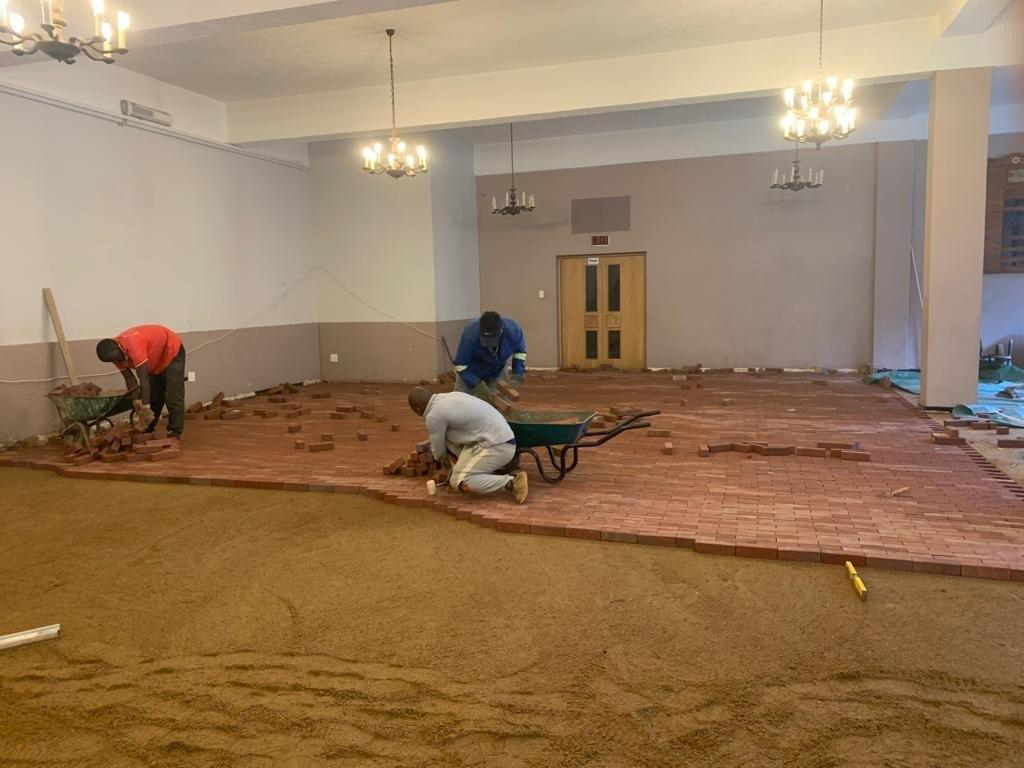
Community

Unfloored by challenges – Greenside Shul saves its hall
Most people don’t think about floors, assuming that we walk on firm ground. But this wasn’t the case at Greenside Shul, where the timbers of the community hall had been rotting away for years and had become a safety hazard, requiring the shul to lock the room and leave it empty.
But, thanks to the grit and determination of the community, ingenious engineering, generous donations, and skilled artisans, the hall is back to its former glory and is being used for the simchas for which it was intended.
“We had been able to use only half the room for years,” said architect Nina Cohen, a director of the shul board, who masterminded the rescue from start to finish. “We knew parts were unstable, but things really came to a head at a Barmitzvah last year, when the floor finally konked in. We had to lock the doors.”
The problem was water. Built in 1947, the shul is close to the Braamfontein Spruit in what’s known as “the Parks”. According to Cohen, it was built too low for the water table, and this is particularly problematic after heavy rains.
After years of budget constraints and then COVID-19, the hall remained locked. A sense of helplessness had crept in along with the damp.
“At the end of last year, I got a bee in my bonnet. I was determined to do something about it,” Cohen said. She got two quotes, both much too expensive.
“I decided to do it myself with my tiler from Zimbabwe, Lennon Dawa.”
However, when they lifted the floor, they got a shock. “We knew there was water underneath,” she said, “but what we saw wasn’t the damp I was expecting, but a river.”
The problem wasn’t just the level of the building, it was inadequate drainage under the floor. “It was like solving a puzzle,” Cohen said, of their attempts to trace historic drainage lines to pumps outside. “There was an attempt at a French drain. We knew there was a pump outside, but none of the water from the hall was going to that pump. It was going to another sump, which was uphill, and blocked with concrete. The water was sitting there with nowhere to go.” That wasn’t all. They found numerous electrical wires running through the water.
“It was a bit shocking. I could see that our budget wasn’t going to hack it,” Cohen said.
So, she reached out to her network. “I called in my friend, [architect] Mark Schaerer, whose father is a contractor. “He said, ‘Oy vey!’”
The more they cleared, the more water they found. So, they built a network of French drains between the beams, running the length of the room. Then, Cohen called her plumber, Nelson Mlalazi, who suggested that instead of draining the water to a sump outside, they build an internal sump under the floor to pump it out. Steelworker Aaron Matsobane Mojela built a steel cover to make it invisible.
The wiring was sorted by another electrician known as “Sam”, who worked through the night until 02:00, rationalising cables and rechannelling the rest against the shul wall, where they could be accessed. Then, Snail Bandawa set to work to re-electrify the existing pump.
Then, they had the challenge of filling in the cavern they had dug half a metre below the floor. Importing filler would be too expensive in a budget-constrained project. So, Cohen brought in civil engineer and Greenside community member Ronnie Scheurenberg, who suggested using rubble mixed with soil from around the area, mixed with a bit of filling material G5. It required a series of layering and compacting. Cohen shlepped the compacter backward and forward in the back of her Subaru to minimise the costs of renting it.
Finally, they had to consider which bricks to use for the floor. But the cost of bricks had jumped 50% between December 2021 and January 2022. Cohen called Corobrik, which she had dealt with over the years as a key sponsor of university architectural competitions.
“Corobrik was helpful, top to bottom. It sponsored the best bricks [for the floor’s surface] we could possibly use,” she said, pointing out that the small, even pavers they used actually cost about five times the price paid by the shul.
In total, the project took about seven weeks.
“We’ve all heard the proverbial phrase that nothing lasts forever,” said the shul’s Rabbi Mendel Rabinowitz. “The downstairs hall at Greenside Shul served our community for more than 65 years. Countless events such as our weekly shiur and brocha on Shabbat and chaggim were all enjoyed in this hall. In addition, many Barmitzvahs and other events took place here. With the passage of time, however, the wooden floor could no longer be used as its timber supports were damaged beyond repair. For a long time, we were forced to snuggle up in the foyer of the shul, and when the weather was favourable, we used the sukkah area adjacent to the shul.
“This Shabbat, we celebrated our third Barmitzvah this year with a renewed sense of purpose. Our shul hall was once again in use. We have a beautiful newly painted hall and most importantly, a brand new, modern brick-paved floor. Thanks to all who contributed towards this project. A big thank you to Nina, who not only found a cost effective solution, but project-managed the entire process.
“We’ve had a great response from the community,” Cohen said. “Everyone is so excited. We have gone from a depressed, COVID-19 stasis to a new floor. We have to infuse new energy into things – and this also relates to infrastructure – not live in a state of decay. As the Torah tells us, a flame lights so many other flames.”







Alfreda Frantzen
September 12, 2024 at 9:23 pm
Wonderful work to restore with all that water!!! Bravo.